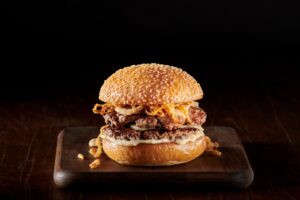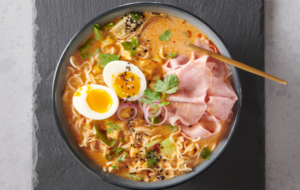Embrace consumers’ desire for carry-out and you’ll be tapping into a huge, profitable opportunity.
Carryout is taking on a whole new meaning for the dining public.
In today’s busy, on-demand world, people want to enjoy restaurant-quality meals at home, at the office, on the road or wherever it’s convenient. We examine this revolution, using expert advice on the operational and culinary angles you need to meet the consumers’ desires.
The Operational Angle
By Doug Owens
Providing restaurant-quality food at home represents a major opportunity for full-service operators. This is the first in a series of articles on how to tap into this growing market.
Today’s consumers have access to more food in more places than ever before—and that means restaurants have more competition for consumer dining dollars.
Retail Meal Solutions (RMS) have become a prominent segment within the foodservice industry, as more and more retail outlets are offering prepared food and beverages that are ready-to-eat or ready-to-heat. In its 2017 Canadian Retailer Meal Solutions Consumer Trend Report, research firm Technomic found that consumers are buying RMS not just from traditional supermarkets, but also from upscale markets, drugstores and C-stores.
At the same time, companies like Berlin-based HelloFresh and Toronto’s Chef’s Plate are expanding their geographical reach across Canada to deliver complete meal-kit solutions direct to consumers’ front doors.
In a 2015 Technomic survey, 75% of customers said that they purchase a retail meal monthly—and that figure jumps to 88% for millennials. The burgeoning popularity of RMS may be affecting the frequency of restaurant visits. “Per-capita consumption has actually decreased by two visits per year,” said Robert Carter, Executive Director, Foodservice Canada at the NPD Group in Toronto, in 2016.
How does a restaurant operator thrive in this new competitive landscape? First, understand what’s driving the proliferation of new dining options—and then leverage your strengths to capitalize on a rapidly growing opportunity.
Bringing it home
Maia Chang, Senior Research Analyst, Consumer Insights for Technomic, says consumers are choosing RMS options over restaurants due to the convenience, value and healthier perception associated with this segment. Therefore, restaurants that want to (re)capture market share from retail foodservice need to address these issues. Ensuring the portability of your food offerings is the first step.
Portable food is easy to access, transport and fit into today’s busy lifestyles. Here are a few tips for enhancing and promoting portability.
1. Analyse your menu. Full-service operators have traditionally made everything on their menus available for takeout and/or delivery. This may not be the best strategy for protecting the integrity of your brand, because not every food item travels well. See Chef Gerry Ludwig’s recommendations for portable menu items in the next section.
2. Think outside the menu box. People don’t necessarily consume meals according to your predetermined serving hours. “We’re seeing some erosion of traditional dayparts and more meals being eaten at untraditional times,” says Aaron Jourden, Managing Editor at Technomic.
Consider incorporating selections from different dayparts into an always-available takeout/delivery menu. How can you scale your breakfast dishes (e.g., breakfast sandwiches) for later in the day? How can you entice a breakfast customer to also purchase a grab-and-go lunch? Make sure you include snacking options, as they are driving more and more restaurant visits.
3. Adjust your marketing. People interact with foodservice meals in different ways—for simple sustenance, to replace meals they’d otherwise have to prepare for themselves and to enhance socializing. Meal replacement is more important during the week and socializing takes precedence on the weekends.
Think about marketing and packaging meals to appeal to these different mind-sets. How can you make it easier to access your food at the end of a workday? How can you enhance the “fun factor” for groups gathering at home to share a meal?
4. Meet customers where they are. “When you look at restaurants 10 or 15 years ago, it was about opening up a place where you serve food and customers come in,” Carter explains. Now, it’s also about getting people to welcome you into their home via portable foods, online ordering, delivery services and curbside pickup.
Carter says operators need to think about designing their overall establishment to accommodate delivery and pick-up orders. Starbucks provides a cautionary tale—the company reported that the popularity of its mobile order-and-pay options caused bottlenecks at pickup areas in 2016, prompting some customers to leave without buying anything.
A Culinary Perspective
By Gerry Ludwig
Some food items travel better than others. Some don’t travel well at all. Analyzing your menu for portability is about identifying dishes that can deliver a quality experience to your customer at home.
Here is a brief overview of some things that work well and others that don’t.
1. Bone-in meats. There’s a reason rotisserie chicken is one of the best-selling take-home dishes—the entire skeletal structure of the animal retains heat and moisture, delivering a superior flavour experience. Bone-in beef, pork and lamb cuts also travel better than their boneless counterparts. They’re also more forgiving if a customer reheats them at home
2. Braised items. Bone-in cuts are also preferable when it comes to less tender cuts of meat. Pork shank, lamb shank and ribs are great examples. If you want to do a boneless meat—say, for a pot roast or beef bourguignon—opt for a large whole-muscle meat as opposed to something like a beef shoulder. In general, larger pieces are better than smaller pieces when it comes to takeaway.
3. Soups. Ready-to-eat soups are ideal. Just make sure you have a container that will hold the heat.
4. Pastas. Noodle dishes generally hold well, but baked casserole styles are best—lasagna, macaroni and cheese and penne risotto, for example. Tomato and meat-based dishes work better than cream-based dishes like fettucine alfredo, which tends to congeal in a fairly short time. Be sure to include extra containers of sauce with pasta dishes.
5. Stir fries. We’re seeing a lot interesting mash-ups in this category, combining traditional fried rice with a whole host of non-Asian ingredients. They’re great candidates for takeaway, as are more conventional rice bowls and noodle bowls. Invest in smaller containers to hold the separate ingredients so customers can “assemble” the dishes at home. An instruction sheet can add fun and sociability.
5. Sharing plates. Speaking of sociability, many items in this category lend themselves well to takeaway. Charcuterie, cheeses, crudités and spreads are great. However, I’d caution you away from toast, bruschetta, crostini and the like—unlike pizza, it’s tough to maintain the integrity of these smaller bread pieces. You should also avoid fried balls like croquettes and arancini.
6. Fried foods. Fried foods in general are problematic, though fried chicken certainly works as long as you have properly vented packaging. (The right packaging is key to making your program work!) Again, the larger the piece the better—so if you feel you must offer fries, consider thick potato wedges cut length-wise.
7. Vegetables. Cooked, un-sauced green vegetables like broccoli and asparagus tend to gray very quickly, which doesn’t exactly appeal to consumers seeking “fresh” and “healthy.” Vegetable sides really require some kind of coating—like a generous amount of butter—to transport well. Of course, vegetables work very well in stews, au gratins and stir fries. Twice-baked potatoes are preferable to conventional baked potatoes.
8. Deconstructed dishes. Those artfully composed dishes you serve in your restaurant are liable to shift into an unrecognizable heap on the way to a customer’s home. That doesn’t mean you can’t or shouldn’t offer them, especially if they’re integral to your brand differentiation. Just package them in separate or compartmentalized containers.
Choosing menu items that will transport well is essential to a successful takeaway program. You may find that you need to add items you don’t currently offer. If they prove successful, consider adding them to your regular menu.
Packaging Considerations
“Packaging needs to carry and enhance food, ensure food safety and reflect well on a restaurant’s brand,” says Steve Weitzman, North American Category Manager for Packaging and Serviceware at Gordon Food Service. He says restaurants are trending toward:
1. Polypropylene. Today’s most common takeout packaging comes in many shapes and sizes, with or without compartments. It retains heat and cold very well and goes from the freezer to the oven, maximizing customer convenience.
2. Paper and Molded Fiber. “Anything that looks like kraft paper is hot because it’s associated with sustainability—even if it’s not really compostable,” Weitzman says. These containers are typically very strong and cut-resistant.
Contact your Sales Representative to determine the best packaging for your needs.

























